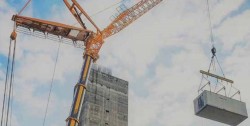When lifting pods or modules there are a number of key questions that must be answered about the load itself before the safest and easiest way to lift can be selected. Anyone who has worked in the offsite sector for an appreciable period of time, will no doubt have seen many different methods of pod/module lifting. In most cases a lifting attachment such as a frame or beam arrangement is required to either stabilise the lift or avoid damage to the pod/module. Considering the following four questions will help you to determine which method is most appropriate.
1. Where are the pod/module lifting points located?
2. How many lifting points are there on the pod/module?
3. How many pods/modules are there to be lifted?
4. How does the weight and size vary between pods/modules?
Considering question one - which from a safety perspective is probably the most important as it can seriously affect the stability of the lift - the two options for the location of the lifting points are simply the top or bottom of the pod. Each method has positive and negative as can be seen in the Table (see above). The biggest potential concern should be the stability of the lift.
If a pod/module is lifted from the bottom, then that pod/module may tip out of the slings if not rigged correctly. The likelihood of this will be increased if the pod is significantly heavy at one end and it has not been accounted for in the rigging or design of the lifting equipment. This does not mean that lifting from the bottom is not acceptable, it may indeed be the best way to lift your pod/module if there are restrictions to lifting from the top.
It would be strongly advisable however, to gain specific guidance from the manufacturer of your lifting system (beams or frames) on the correct and safe method of rigging when lifting from the bottom. The second question posed was about the number of lifting points. This question is also of key importance as it will help guide the selection of the most appropriate lifting attachment to facilitate the lift of the pod/module. The number of lifting points is also usually critical for the distribution of self-weight throughout the pod/ module.
A '4-point lift' generally best suits the use of a fixed spreader frame and is commonly used for the lighter and smaller pods. A '6 or more point lift', usually requires a more complex rig involving multiple beams or a large frame capable of receiving the bending load produced as a result of lifting from multiple points. This in turn pushes up the cost of sourcing the lifting attachments - as such '6 or more point lifts' are usually restricted to larger, heavier modules where it is not possible to lift from fewer points. Finally, questions three and four relate to the number of a pods and the variance in weight and size.
The heaviest pods are best lifted by a spreader beam arrangement as they deal primarily with compressive forces and are a much more cost-effective option for lifting heavy loads than a frame. The time required to adjust such a rig should be considered and may be mitigated via the use of telescopic systems. For speed of adjustment and particularly where headroom may be an issue, a heavy-duty frame with adjustable lifting points is usually the most appropriate solution.









